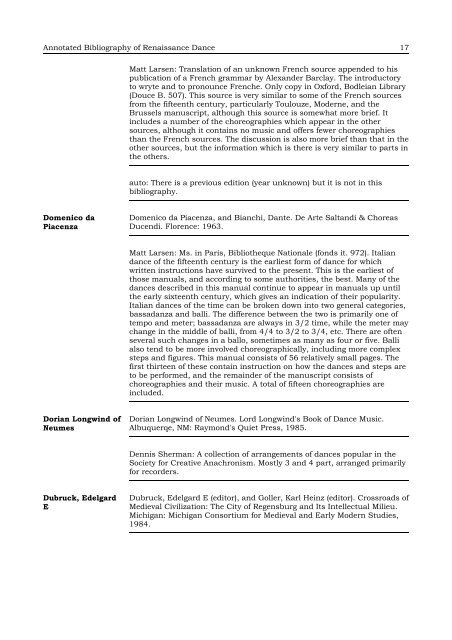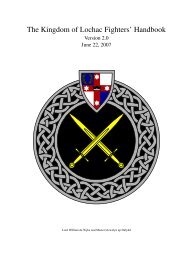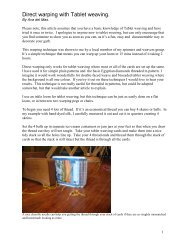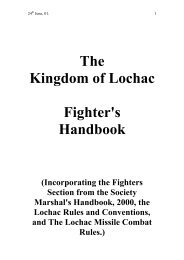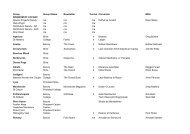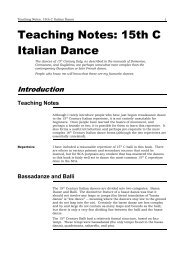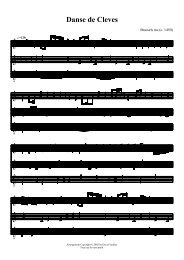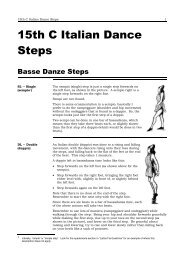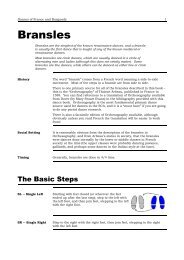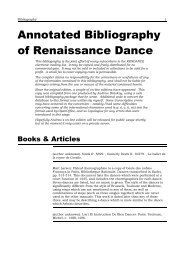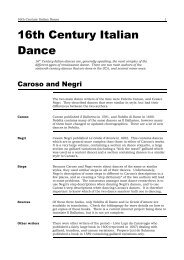Annotated Bibliography of Renaissance Dance - Shadow Island ...
Annotated Bibliography of Renaissance Dance - Shadow Island ...
Annotated Bibliography of Renaissance Dance - Shadow Island ...
- No tags were found...
Create successful ePaper yourself
Turn your PDF publications into a flip-book with our unique Google optimized e-Paper software.
<strong>Annotated</strong> <strong>Bibliography</strong> <strong>of</strong> <strong>Renaissance</strong> <strong>Dance</strong> 17Matt Larsen: Translation <strong>of</strong> an unknown French source appended to hispublication <strong>of</strong> a French grammar by Alexander Barclay. The introductoryto wryte and to pronounce Frenche. Only copy in Oxford, Bodleian Library(Douce B. 507). This source is very similar to some <strong>of</strong> the French sourcesfrom the fifteenth century, particularly Toulouze, Moderne, and theBrussels manuscript, although this source is somewhat more brief. Itincludes a number <strong>of</strong> the choreographies which appear in the othersources, although it contains no music and <strong>of</strong>fers fewer choreographiesthan the French sources. The discussion is also more brief than that in theother sources, but the information which is there is very similar to parts inthe others.auto: There is a previous edition (year unknown) but it is not in thisbibliography.Domenico daPiacenzaDomenico da Piacenza, and Bianchi, Dante. De Arte Saltandi & ChoreasDucendi. Florence: 1963.Matt Larsen: Ms. in Paris, Bibliotheque Nationale (fonds it. 972). Italiandance <strong>of</strong> the fifteenth century is the earliest form <strong>of</strong> dance for whichwritten instructions have survived to the present. This is the earliest <strong>of</strong>those manuals, and according to some authorities, the best. Many <strong>of</strong> thedances described in this manual continue to appear in manuals up untilthe early sixteenth century, which gives an indication <strong>of</strong> their popularity.Italian dances <strong>of</strong> the time can be broken down into two general categories,bassadanza and balli. The difference between the two is primarily one <strong>of</strong>tempo and meter; bassadanza are always in 3/2 time, while the meter maychange in the middle <strong>of</strong> balli, from 4/4 to 3/2 to 3/4, etc. There are <strong>of</strong>tenseveral such changes in a ballo, sometimes as many as four or five. Ballialso tend to be more involved choreographically, including more complexsteps and figures. This manual consists <strong>of</strong> 56 relatively small pages. Thefirst thirteen <strong>of</strong> these contain instruction on how the dances and steps areto be performed, and the remainder <strong>of</strong> the manuscript consists <strong>of</strong>choreographies and their music. A total <strong>of</strong> fifteen choreographies areincluded.Dorian Longwind <strong>of</strong>NeumesDorian Longwind <strong>of</strong> Neumes. Lord Longwind's Book <strong>of</strong> <strong>Dance</strong> Music.Albuquerqe, NM: Raymond's Quiet Press, 1985.Dennis Sherman: A collection <strong>of</strong> arrangements <strong>of</strong> dances popular in theSociety for Creative Anachronism. Mostly 3 and 4 part, arranged primarilyfor recorders.Dubruck, EdelgardEDubruck, Edelgard E (editor), and Goller, Karl Heinz (editor). Crossroads <strong>of</strong>Medieval Civilization: The City <strong>of</strong> Regensburg and Its Intellectual Milieu.Michigan: Michigan Consortium for Medieval and Early Modern Studies,1984.


